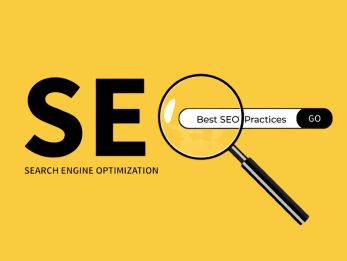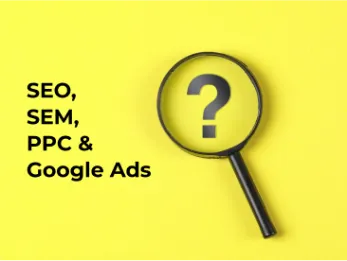Top SEO strategies to follow in 2024
6 mins | 23 May 2023

In today's digital age, having a website or an online presence is essential for any business or individual looking to expand their reach and connect with a wider audience. However, simply having a website is not enough; you need to ensure that your website is easily discoverable by search engines and that it ranks high in search engine results pages (SERPs). This is where Search Engine Optimization (SEO) comes into play.
What is SEO?
Unless you are living under a rock, you might be aware of this term. For the unversed, SEO stands for “search engine optimization.” In simple terms, SEO means the process of improving your website to increase its visibility in Google, Microsoft Bing, and other search engines whenever people search for:
- Products you sell.
- Services you provide.
- Information on topics in which you have deep expertise and/or experience.
The better visibility your pages have in search results, the more likely you are to be found and clicked on. Ultimately, the goal of search engine optimization is to help attract website visitors who will become customers, clients, or an audience that keeps coming back.
What are the types of SEO?
Typically, there are three main types of SEO:
On-page SEO:
This refers to the optimization of the content and HTML source code of your website pages. On-page SEO involves optimizing the content of your web pages, including your headlines, images, internal links, and keyword usage, to make them more relevant and valuable to both users and search engines. On-page SEO also includes optimizing the technical aspects of your website such as page speed, mobile responsiveness, and meta tags to improve its usability and search engine crawlability.
Off-page SEO:
This refers to the optimization of external factors that affect your website's ranking in search engine results pages (SERPs). Off-page SEO includes activities like link building, social media marketing, and brand mentions. The primary goal of off-page SEO is to increase the number and quality of backlinks pointing to your website, which can improve your website's domain authority and credibility in the eyes of search engines.
Technical SEO:
This refers to the optimization of the technical aspects of your website, such as the site architecture, page speed, indexing, and crawl ability, to improve its visibility and ranking in search engine results pages. Technical SEO involves implementing technical fixes to your website to ensure it is easily crawled and indexed by search engines, thereby improving the user experience and search engine visibility of your site. Technical SEO also involves making sure that your website adheres to Google's webmaster guidelines and follows best practices for website optimization.
What are the best SEO practices every SEO professional should follow?
As SEO is divided into three broader sections, we have curated the best practices for each SEO type. They are as follows:
Best practices for on-page SEO:
- Writing catchy meta titles: A catchy and attention-grabbing meta title is required for every webpage that needs to be crawled. Make sure the page title is under 60 characters. The ideal length for the meta title is 50–60 characters. Google starts to cut off the title tag after 50-60 characters. Hence it is a good practice to keep your title tag around this length
- Writing accurate meta descriptions: A meta description tag generally informs and interests users with a short, relevant summary of what a particular page is about. While meta descriptions can be any chosen length, it's important to note that Google will only show between 155 to 160 characters in total. Anything longer, and Google will cut it out. If you find it hard to keep the description concise, then Editpad summarizer can help remove extra wording to fit with Google's recommended description limit.
- URL Structure: Having a small and accurate URL for every webpage is an essential parameter for SEOs. Though it may seem less important than the title and heading elements URLs can be a powerful tool for achieving SEO success.
- Use Header Tags in your Content: Header tags, also known as heading tags, are used to separate headings and subheadings on a webpage. They rank in order of importance, from H1 to H6, with H1s usually being the title. Header tags improve the readability and SEO of a webpage.
- Ensure your content has high readability: As an SEO professional, you need to be aware of your copy’s readability and actively take steps to increase it. Use short, easy-to-read words. Additionally, drop any jargon and shorten your sentences.
- Tighten your internal linking strategy: Generally speaking, the more links a page has—from both external and internal sources—the higher its PageRank. This is the foundation of Google’s ranking algorithm and remains important even today.
- Use an effective image optimization strategy: Optimizing images isn’t just about making the size of the images smaller. You should also add alt tags and use descriptive filenames. Both of these things help Google understand your images, which can help your pages rank for long-tail keywords in web searches—and in Google Images.
- Add structured data to your page: Structured data is important for SEO because it'll make it easier for Google to understand what your pages, products, and website are about.
Best practices for off-page SEO:
- Try link building: Backlinks are the foundation of Google’s algorithm and remain one of the most important ranking factors. Try and build more and more backlinks to make your off-page strategy stronger.
- Utilize social listening platforms: Social listening is quickly becoming an important customer intelligence tool. Using social listening tools, you can gather data that will help you refine your content and take it one step higher.
- Optimize your Google My Business Profile: By optimizing your Google Business profile, you're communicating to Google that you are a relevant search result for those consumers. An optimized Google Business Profile can increase your chances of showing up in Google's local search results.
- Manage your user reviews: As a business, you are bound to get positive and negative feedback. As an SEO professional, you need to ensure you get more and more authentic reviews for your business.
- Promote your business on social media: In today’s age, social media plays a vital role in boosting the online identity of an organization. Ensure you have a social media bucket that is consistently putting out content on Facebook, Twitter, Instagram, Linkedin, and others.
- Submit your events on various submission sites: Event submission sites are a valuable free online technique for relevant backlinks to attract website traffic and increase brand awareness. So, whenever you are having an event at your organization, submit it on the various event submission websites.
Best practices for technical SEO:
- Always have an SSL certificate: A website needs an SSL certificate to keep user data secure, verify ownership of the website, prevent attackers from creating a fake version of the site, and gain user trust. For optimum results, install an SSL certificate for your website.
- W3C validation: If you’re new to SEO, then this is a very important step that you shouldn’t miss. In W3C validation, a website's code is checked to determine if it follows the formatting standards. If you fail to validate your website's pages based on W3C standards, your website will most likely suffer from errors or poor traffic owing to poor formatting and readability.
- Fix broken links & pages: Broken links and pages give wrong links to the user. It tells the user that your business is not trustworthy. Too many broken external links also send signals to Google that your site is outdated, and it could be harmful to rankings. So, you should fix the broken links and pages that are present on your website.
- Add Sitemap.xml and HTML sitemap to your website: Adding a sitemap to your website is essential. Building and submitting a sitemap is one of the best ways to ensure all of the valuable content on your site can be found by search engines. You need to add both XML and HTML sitemap to your website. An XML sitemap is a file intended to be read by search engine robots, while an HTML sitemap is intended to be read by the users.
- Make the website mobile-friendly: Mobile-friendly websites boost your sales and conversions because there is an ease of accessibility that surrounds this website design. Knowing that a mobile-friendly website allows users to interact and engage with your brand across devices without being annoyed or inconvenienced.
- Improve the website's overall speed: Speed plays a decisive role in how audiences perceive a brand on the web. It is human tendency to consider a faster website more reliable and professional. Inversely, a slow website is mostly annoying for users. Most users bounce immediately and prefer visiting other, faster websites to meet their requirements.
- Optimize the core web vitals of your website: Core Web Vitals are important for SEO, as they can help give your website more recognition and keep it organized and clean. These vitals can help improve your website's visibility and ranking in browsers and give your audience a hassle-free experience while browsing your page.
- Use Hreflang on your website: The hreflang attribute (also referred to as rel="alternate" hreflang="x") tells Google which language you are using on a specific page, so the search engine can serve that result to users searching in that language. The hreflang attribute is very helpful in local SEO. Scratching your head? Check out one of the most complex websites across the world that utilizes hreflang attribute wonderfully; UPL.
Conclusion:
In conclusion, implementing the best SEO practices is critical to the success of any online business. By optimizing your website for search engines, you can increase your visibility, attract more traffic, and, ultimately, drive more conversions and revenue.
However, it's important to note that SEO is an ongoing process, and you need to constantly monitor your website's performance and adjust your strategy accordingly. By staying up-to-date with the latest SEO trends and best practices, you can stay ahead of the competition and achieve long-term success in the online marketplace.
Remember, SEO is not a one-size-fits-all solution, and what works for one website may not work for another. Therefore, it's important to experiment, measure your results, and make data-driven decisions to optimize your website for search engines and achieve your business goals.
Overall, by following these best SEO practices and continuously refining your strategy, you can create a strong online presence, drive more traffic, and grow your business in the competitive digital landscape.
Author









